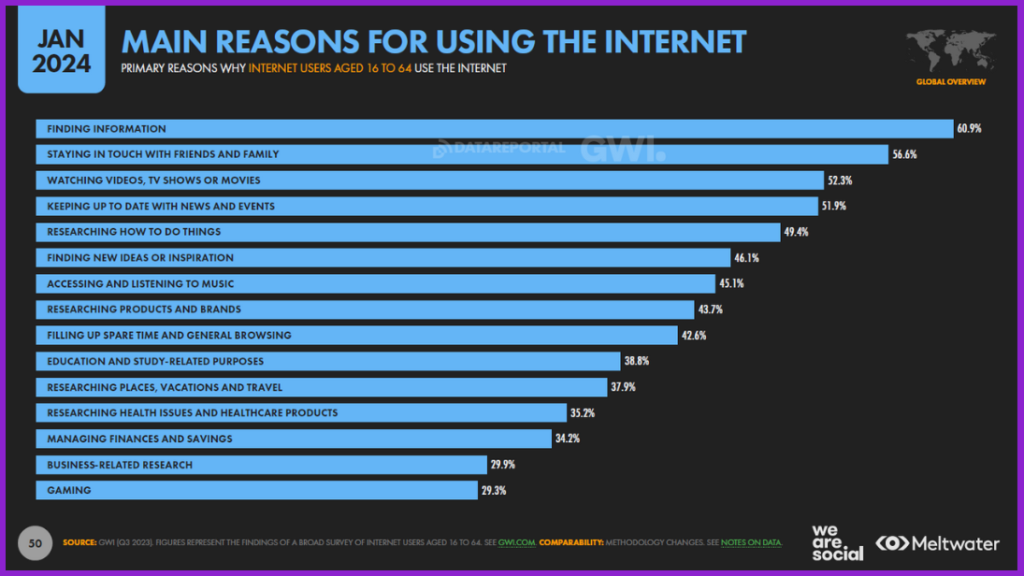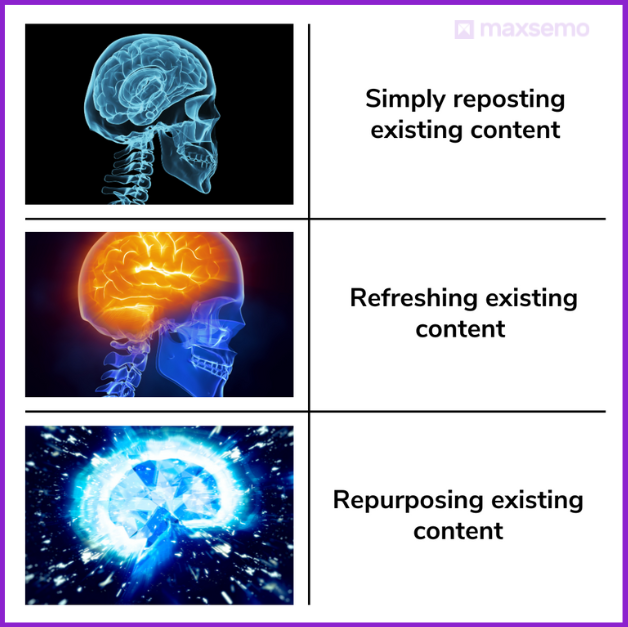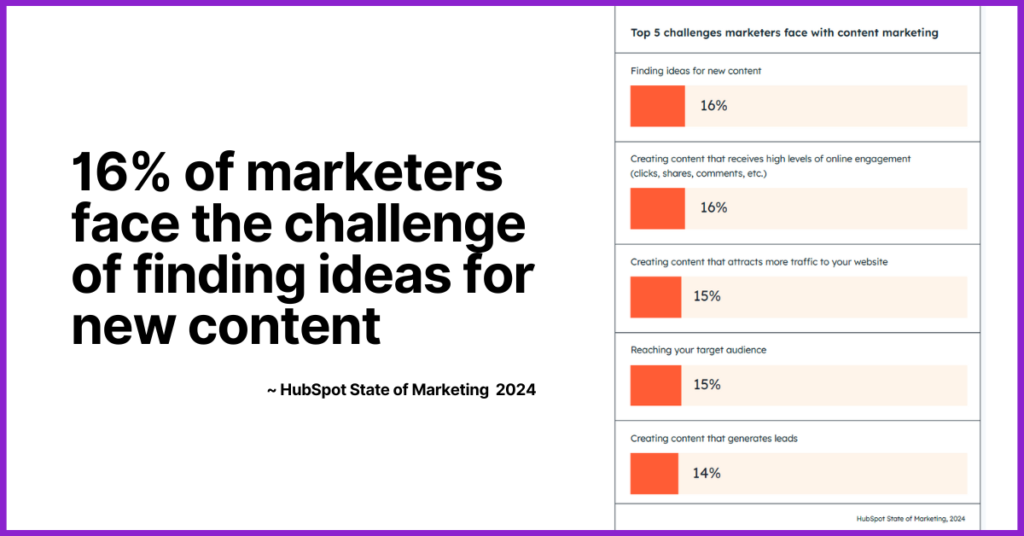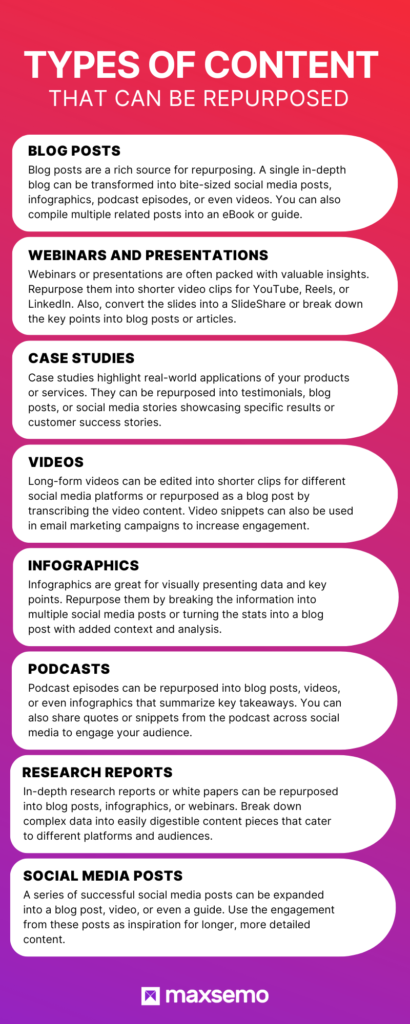
Imagine writing a stellar blog post—well-researched, crisply written, and full of insights. You publish it, promote it, and watch as it draws in readers and engagement.
But after a few weeks, the buzz fades, and the post sinks into your archive, its potential untapped.
Now, instead of letting that content gather dust, you transform it into a vibrant infographic, a punchy video for YouTube, or even a podcast episode.
That single post morphs into multiple high-impact pieces, engaging different audience segments.
This is the power of content repurposing—reshaping your best ideas into various formats to extend their lifespan and relevance.
It’s a smart strategy to maximize resources, boost SEO, and engage your audience consistently.
In this blog, we’ll explore how repurposing can breathe new life into your content marketing efforts.
What is Content Repurposing?
Content repurposing is the process of taking existing content and transforming it into different formats or adapting it for new platforms.
Rather than letting valuable content fade into obscurity after its initial use, repurposing allows you to breathe new life into it by presenting the same core ideas in fresh, engaging ways.
This strategy enables you to reach different audience segments and maximize the impact of your original work.
Introducing Maxsemo’s FREE SEO Tools to Boost Your Search Visibility on YouTube.
✓ no ads
✓ free to use
The beauty of repurposing lies in its ability to tailor content to fit various consumption habits.
For instance, long-form content such as blog posts can be broken down into bite-sized social media posts, while webinars or podcasts can be transcribed into articles or guides.
This not only expands your content’s reach but also ensures that it remains relevant and accessible over time.
People still use internet to find information with 60% of them aged between 16 and 64, according to 2024 Global Digital Report by Meltwater.
This means that the information on your website has great potential of being discovered on various online platforms, if it is repurposed properly.

Here’s an example.
A detailed blog post on “Digital Marketing Consulting” can be repurposed into an infographic highlighting key consulting benefits, a series of short videos explaining different aspects of the service, and even a podcast episode discussing how businesses can benefit from working with a digital marketing consultant.
Difference Between Repurposing and Simply Reposting or Refreshing Content
While repurposing, reposting, and refreshing content might seem similar, they serve different purposes.
Reposting is simply sharing the same content again on different platforms or at a later time.
It helps increase visibility but doesn’t offer anything new.
Refreshing content involves updating an old piece with new information, data, or optimization to keep it relevant.
Repurposing, however, goes beyond these tactics.
It transforms existing content into a completely new format, allowing it to reach different audiences.

For example, a detailed blog post can be repurposed into an infographic, a podcast episode, or a series of social media posts, making the most of the original material by adapting it for different platforms and preferences.
Why Repurposing is an Evergreen Content Marketing Tactic
Repurposing content is a powerful way to extend the lifespan of your existing material.
Instead of letting a well-researched blog post or video fade into obscurity after its initial release, repurposing allows you to keep your content relevant.
By transforming it into different formats – such as turning a blog into an infographic or a video series – you can reintroduce it to your audience in fresh ways, giving it new life long after the original publication.
Not only does repurposing extend content longevity, but it also helps you reach new audiences across different platforms.
Different people prefer consuming content in different ways—some might love reading detailed blogs, while others may prefer watching short videos or skimming through social media posts.
By adapting your content for various formats, you can tap into different audience segments that might have missed the original piece.
Moreover, repurposing content is a time-efficient strategy compared to creating entirely new content from scratch.
Repurposing can overcome the challenge faced by many marketers in finding new ideas for new content.

Instead of starting with a blank slate, you can build on existing ideas, saving valuable time while maintaining consistency in your messaging.
This approach allows you to maximize the value of your original work without sacrificing quality, ensuring you get the most out of your content creation efforts.
Benefits of Content Repurposing
1. Maximizes Content ROI
Repurposing helps you get more mileage out of the content you’ve already invested time and resources into.
By transforming one piece into multiple formats, you increase its reach and effectiveness, boosting your overall return on investment.
2. Expands Audience Reach
Different platforms attract different types of audiences.
By repurposing content into various formats—like videos, podcasts, infographics, or social media posts—you can engage new audience segments that might prefer different content formats.
This allows you to reach more people with the same core message.
3. Boosts SEO Performance
Creating multiple pieces of content around a single topic increases your chances of being discovered in search engines.
Repurposed content can also generate more backlinks, which further improves your SEO and helps you rank higher on search results.
Do you know that brand monitoring helps in boosting your SEO efforts? Check out the article here.
Or, you can use SEO to generate branded search traffic to your website. How? Check out the article here.
4. Saves Time and Resources
Developing fresh content can be time-consuming.
Repurposing allows you to leverage existing content, reducing the time and effort required to create new materials.
It’s a smart way to maintain a steady content flow without constantly starting from scratch.
5. Reinforces Your Message
Repetition is key in marketing.
Repurposing allows you to share your core message in different formats, reinforcing it across multiple touchpoints.
This ensures your audience gets repeated exposure to your ideas, making your message more memorable.
6. Enhances Content Consistency
Repurposing ensures consistency in your brand’s messaging and voice.
By using the same core ideas across different platforms and formats, you create a unified narrative that builds trust and recognition with your audience.
Types of Content That Can Be Repurposed [Infographic]
Almost any type of content can be repurposed, making it a flexible and powerful strategy.
Here are some key content types that work particularly well for repurposing:

Practical Steps for Repurposing Content
Repurposing content requires a strategic approach to ensure your message resonates across platforms. Here are the practical steps to follow:
1. Identify High-Performing Content
Start by selecting content that has already proven successful with your audience.
Look for blog posts, videos, or social media posts that have garnered high engagement, as these are more likely to perform well when repurposed.
2. Tailor Content to the Platform
Each platform has its own format and audience preferences, so it’s crucial to adapt your content accordingly.
For example, a long-form blog post might work well on LinkedIn, but on Instagram, you’ll want to break it down into concise, visually engaging posts.
Similarly, a detailed report can be turned into an infographic for Pinterest or a quick how-to video for YouTube.
3. Change the Format to Suit Different Consumption Styles
Repurposing is about making the same message accessible to different audiences.
Some prefer reading blog posts, while others may like watching videos or listening to podcasts.
By changing the format turning an article into a video, or a webinar into a series of short podcasts you can reach those who might not have engaged with the original content.
4. Focus on Key Takeaways
When repurposing content, extract the main points and insights that can be reworked into new formats.
For example, a blog post with five key strategies can be turned into a series of Instagram posts or tweets, each featuring one tip.
This ensures the essence of the content is maintained, while making it more digestible for different platforms.
5. Keep the Audience in Mind
Tailor each piece of repurposed content to the specific audience of the platform you’re sharing it on.
LinkedIn’s audience may respond well to professional insights, while TikTok or Instagram audiences may prefer quick, creative, and visually engaging content. Always consider who you are trying to reach and what format they prefer.
6. Leverage Multimedia
Diversify your content by turning text into visuals, audio, or video.
For instance, blog posts can become podcasts, data points can be turned into infographics, and long-form articles can be broken down into slides or presentations.
This not only makes your content more accessible but also appeals to varied consumption habits.
7. Track Performance and Optimize
Once you’ve repurposed your content, track its performance across different platforms.
This will help you identify what resonates with each audience, allowing you to further refine your strategy.
Use metrics such as engagement rates, shares, and views to measure success and adjust as needed.
Tools that Can Help with Content Repurposing
| Tool | Purpose | How It Helps with Repurposing |
| Canva | Visual Content Creation | Create infographics, social media posts, and presentations from blog content. |
| Invideo.ai, Lumen5 | Video Creation | Turn blog posts or articles into engaging videos with minimal effort. |
| Descript | Audio/Video Editing | Convert podcasts into videos, transcribe audio to create blog posts or articles. |
| Otter.ai | Transcription | Automatically transcribe audio or video content into text for blog posts or captions. |
| Repurpose.io | Multi-Platform Content Repurposing | Automate sharing of videos, podcasts, and live streams across platforms like YouTube, Facebook, and Instagram. |
| Anchor | Podcast Hosting and Conversion | Turn blog posts into audio content or podcasts, and distribute them across multiple platforms. |
| Buffer | Social Media Management | Schedule and repurpose blog content into social media posts across various platforms. |
| SlideShare | Presentation Hosting | Repurpose blog posts or reports into slide presentations for LinkedIn and other platforms. |
| BuzzSumo | Content Ideas and Insights | Identify trending topics to update and repurpose existing content based on what’s relevant. |
| ConvertKit | Email Marketing Automation | Repurpose blog content into newsletter formats and distribute to your email audience. |
Best Practices for Repurposing Content
1. Start with High-Performing Content
Always choose content that has already resonated well with your audience. Repurposing popular content increases the chances of continued success across platforms.
2. Adapt for Each Platform
Tailor your content format and messaging for each platform.
What works on LinkedIn might not work on Instagram, Reddit, or TikTok, so adjust to meet the expectations of each audience.
3. Focus on Key Insights
When repurposing, extract the main takeaways or data points.
Presenting the most valuable aspects of the original content ensures that the core message remains impactful.
4. Keep Branding Consistent
While adapting the format, make sure the tone, voice, and branding are consistent. This maintains cohesion and reinforces your brand’s identity across channels.
5. Use Visuals to Enhance Engagement
Whenever possible, incorporate visuals such as infographics, slides, or short videos. Visuals boost engagement, especially on social media and multimedia platforms.
6. Track Performance
Monitor how repurposed content performs on different platforms. Use metrics to refine your strategy, optimizing future content repurposing efforts.
Conclusion
Content repurposing is a smart way to extend the lifespan of your work, reach new audiences, and make the most of your resources.
By transforming existing content into new formats, you keep your message relevant and engaging across platforms.
In today’s fast-paced world, repurposing is essential for keeping your content marketing strategy fresh and effective.
Start exploring your existing content for new opportunities!
Want more marketing tips?
Subscribe to our content updates and stay ahead with the latest insights!




